Content Marketing for Law Firms: 2025 Guide
Law firm content marketing is a crucial digital marketing strategy. but often associated with being boring. The topics you write about are complex, and the “official” sounding language law firms are associated with is dry. But it need not be that way.
Asound legal content strategy aims to reach and resonate with only a few people interested in your legal services.
By creating educational content that helps your prospects —possibly in distress and considering legal recourse — you can earn their trust. Your free value can often lead them to consider hiring your legal services.
In this article, I’ll show you how to create a content marketing strategy that resonates with your target audience and earns you high-quality leads every month.
What is Legal Content Marketing?
Content marketing for law firms is creating valuable content — such as a blog post, email newsletter, or social media post — around the pressing issues of your target audience. It also involves promoting the content through relevant marketing channels to ensure it gets visibility in front of your potential clients.
For example, for one of our clients, Jesse Minc, we created 15k words of content. In this case, they were the practice area pages for their website to help them rank in search engines for relevant keywords.

Why is Content Marketing Important for Law Firms?
Effective content marketing strategies can demonstrate your legal expertise and create awareness for your legal services. A fully optimized content marketing funnel is your ticket to getting more clients.
For instance, one of our clients, Stroleny Law, a premier criminal defense attorney in Miami, saw an increase in its organic rankings in a few months of working with us:

And that translated into an increase in their incoming leads:

We cover their story in detail in our law firm SEO case study. The key while creating any piece of content is to tweak your style for the marketing channel you want to distribute it on, or just hire our legal content writing services 😉
Which Channels Should You Focus on for Law Firm Content Marketing?
As a marketing agency specializing in search engine optimization for law firms, we base our content creation services almost exclusively on search engines — relying on legal keyword research.
This can appear to be an incomplete strategy.
- The “optimized” legal content created for earning search engine rankings can feel manufactured and dry,
- Many marketers are biased toward shiny social media tactics for lawyers and consider building a presence on LinkedIn, Instagram or even TikTok!
Well, let’s address these objections. For point one, you can create guidelines for your writers to create engaging content that’s still optimized for search (we’ll give a peek of our process later in the article).
To point two above, we have found that social media is rarely helpful for law disciplines such as criminal defense and personal injury. Instead, boring practice area pages end up driving high-quality traffic to their websites.
Don’t get me wrong. Social media is a viable law firm marketing strategy. It can work for specific legal industry disciplines. If you find your competitors using some social platforms, you can experiment with them.
Think of it this way:
Why would someone search for a personal injury or defense lawyer on Instagram when considering immediate legal recourse?
Also, leads from organic search tend to convert at a much higher rate (at 4%) than other marketing channels (that convert at 2.4%).
Getting high-quality traffic from search engines is often sufficient for attorneys. Remember, we also focus on local SEO for law firms, so your content strategy doesn’t miss out on your local target audience.
Our content — built for search — has helped our clients as Stroleny Law, increase leads by 4000% in 10 months, so our approach works like a charm for our clients.

Of course, you’re always welcome to enlist the help of external agencies or freelancers to nail the technical aspects of SEO down. While most law firms like to keep their content creation in-house, they often outsource advanced SEO tasks to fill gaps in terms of knowledge and tools.
Here’s what Andrew Pickett, owner of Andrew Pickett Law, has to say:

To enhance marketing effectiveness, we apply SEO techniques to broaden our reach and boost online visibility. Our content creation strategy combines in-house writing with the expertise of specialized legal writers and external agencies for select projects, allowing us to maintain authenticity and depth in our communications while fostering client engagement.

In the next section, I’ll explain how you can build a robust content strategy for your law firm website and reap compounding returns from your efforts. We’re majorly sharing our experience.
How to Create a Content Marketing Strategy for your Law Firm
Our agency publishes multi-million words yearly for our clients. But this isn’t creative writing without any purpose — these articles generate leads for our clients and improve their site’s organic traffic. Here’s an example of the results for one of our clients:
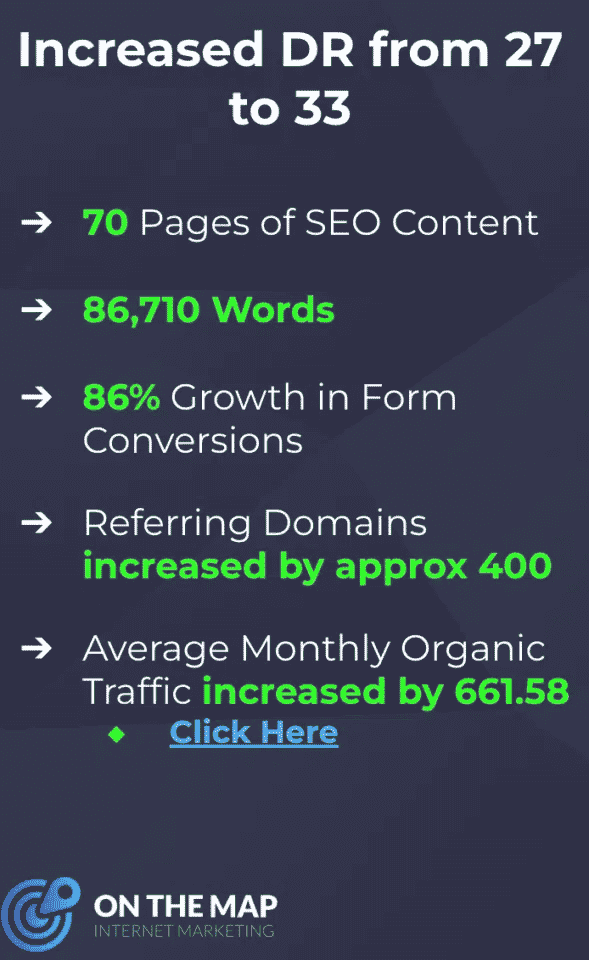
In the next section, let’s look at a step-by-step process to create a formidable content marketing plan that can get you results like our clients.
Disclaimer: If your firm is looking for a quick influx of leads, we recommend hiring our legal PPC services. Content marketing and law firm SEO take time. Typically, Google warms up to a website in about six months or more, depending on many factors, including the competition in your market.
Step 1: Set Content Marketing Goals
Some primary goals that attorneys want to achieve with content marketing could be creating brand awareness, improving organic rankings, getting organic traffic, and generating leads and new clients.
You need to choose one or more from the above and then rely on relevant metrics to measure your progress. For example, for the executive business reviews (EBR) of our clients, we share our standings related to:
- Domain rating
- Monthly traffic
- Referring domains
- Form conversions
- Number of pages of content we delivered (and the number of words we wrote)
Here’s an example overview slide from one of our EBR presentations:

An increase in targeted search engine traffic typically increases conversions. And an improvement in referring domains, domain rating, and the number of pages on a site can often help your search traffic numbers.
So as visible in our EBR above, we rely on a mix of lagging indicators such as links built and content produced — but also track our conversions. It ensures we can fine tune any aspect of our projects that aren’t working and associate our efforts with results.
If you’re pursuing social media or email marketing, you can rely on lagging indicators such as followers or subscribers. But also track your leads and conversions. Always rely on a mix of metrics closer to your bottom line and the ones leading up to them.
If you’re working with a digital marketing agency, then make them accountable for the output of your content marketing efforts, such as leads, rankings, and traffic. Do not get sold on deliverables like a certain number of articles per month. You ultimately want to get more of your ideal clients.
Step 2: Conduct Competitive Content Marketing Research
Once you have goals and related metrics in order, it’s time to survey the market and understand how your competitors are pursuing content marketing. Start with creating personas and the demographic of your target audience.
Next, make a list of 3-5 of your competitors. Then visit their websites and social profiles to answer questions such as:
- What marketing channels are your competitors pursuing?
- Is a competing attorney actively participating in a Facebook group or posting on LinkedIn?
- Do they have an email newsletter?
- What kind of content (and at what frequency) are these competitors publishing?
- What types of content do they publish and at what frequency?
- Do they publish video content and have an active YouTube channel?
- Do they send out a podcast episode live every week?
- How much website traffic do their websites get (use tools like Ahrefs and SimilarWeb for finding the same)?
- What are the organic keywords their sites are ranking for?
- What’s their domain rating (DR), and the sites they have gotten links from?
The answers will help you explore the tactics already working in your market. You can integrate them into your content strategy as long as they match your broader marketing objectives.
Michael Farah, founder and managing attorney at The Farah Law Firm, P.C., says this about his firm’s diverse content strategy:

Our law firm produces most of its content for client education and legal insights. We write articles, newsletters, and quick-tip videos that provide straightforward, actionable legal advice for the everyday issues our clients face. We help to demystify the law and present our firm as a helpful resource—a central element of our brand.

For example, in your research, you may find that your competitors are publishing informational legal blog posts regularly.

It’s worthwhile to evaluate the results of such blogging efforts and find the subjects that drive them relevant traffic:

But more often, our SEO tech finds competitors covering a cluster of subjects around your law discipline. For instance, a divorce attorney may host informational guides like Farzad & Ochoa Family Law Attorneys, LLP:
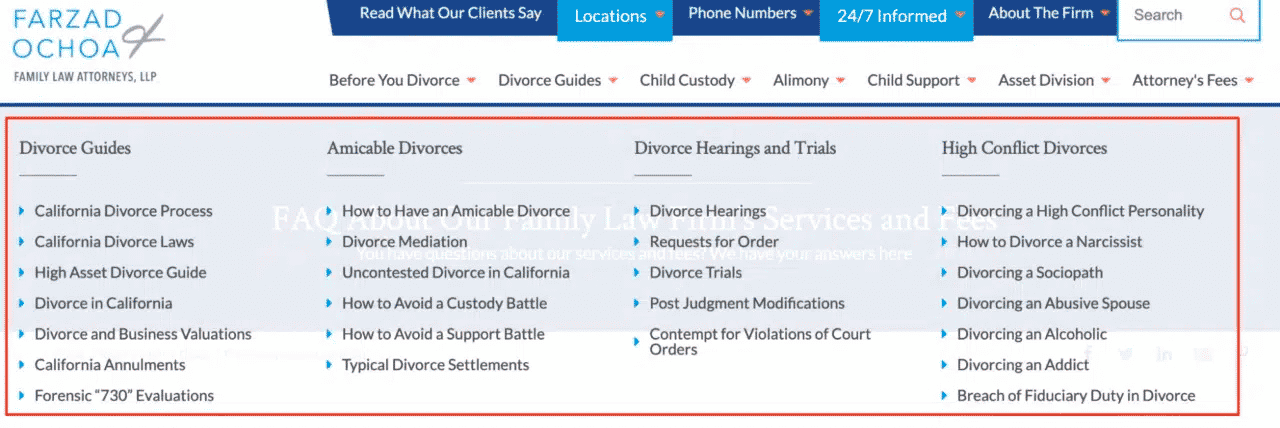
These could also be practice area pages — and as you’ll see in the next step — our SEO tech usually begins recommending closing such content gaps.
Note: If we’re a mutual fit, our SEO strategists conduct a free SEO audit for your website, including a thorough competitor analysis. It can include an analysis of the keywords, domain rating, and the site structure of your competitors — the areas where your website can use some work. Contact us if you want such a free audit for your website.
Use Questions Asked by your Prospective Clients to Find More Ideas
Besides competitor analysis, I highly recommend you seed content ideas and inspiration for your content strategy based on your conversations with your customers.
- Do your prospective clients repeatedly ask you similar questions?
- Is there a channel or source they often know about you from?
Then it may make sense to integrate these content ideas and channels into your strategy.
For reference, Moton Legal Group owner M. Denzell Moton, Esq, ensures his website has all the content their prospects need:

We focus on creating content around business formation, contract drafting, compliance, and intellectual property. We have a style guide to ensure consistency across our website, social media, and email marketing. Our in-house team drafts the majority of our content custom-tailored for our ideal clients’ needs and questions.
For example, when business owners come to us for help forming their company, we provide educational materials on the pros and cons of different legal structures (LLC vs. Corporation). We track how often these resources are downloaded and use feedback forms to improve the content. Since implementing this strategy, we’ve seen a 35% increase in new client consultations.

You can try putting these recurring questions in an SEO tool such as Ahrefs to discover its potential to drive organic traffic. Even if you find the related keywords have a low volume (under 10 per month), cover such topics on your blog because they are of keen interest to your prospects.
When crafting your content, try to incorporate actionable tips to drive prospects into becoming paying clients.
Julia Rueschemeyer, owner of Attorney Julia Rueschemeyer Divorce Mediation, cuts no corners when it comes to creating an actionable content experience for her audience:

My content is designed to answer people’s questions and give them information about divorce, dividing pensions, and the peculiarities of probate courts in Massachusetts. I give away information, including complicated financial calculators, that people would pay thousands of dollars for at any law firm.
I give instructions that would allow an organized, detail-oriented person to do their divorce themselves (but very, very few do). By giving away so much expertise for free, and by taking the mystery out of the processes, my site comes up high for many searches. My site outperforms sites for firms with 10x as many attorneys and marketing budgets 20x as high as mine.

Step 3: Map Your Ideas to an Editorial Calendar and Establish a Publishing Workflow
Once you have evaluated content ideas and recognized the ones that can get you more of your ideal clients, it’s time to organize your content calendar.
Andy Gillin, managing partner at GJEL Accident Attorneys, mentions the benefits of using a content calendar in their firm:

A practical tip for ensuring content quality and effectiveness is to employ a “content calendar.” This tool helps us plan, track, and organize content around key legal issues and events, ensuring timely and relevant posts that engage our audience and improve our search engine ranking.

Typically you should prioritize mapping the practice area pages — which are regarded as the most “salesy”, money pages for an attorney. These are created to persuade the prospects ready to hire an attorney. Here’s an example of practice area pages mapped out for a personal injury lawyer to help their SEO efforts:

You can use a project management tool such as Trello for managing the publishing workflow. It lets you add collaborators to every card, attach deadlines, add checklists, and more. Here’s what your blog’s Kanban board may look like allowing you to visualize and manage the different stages of your articles:
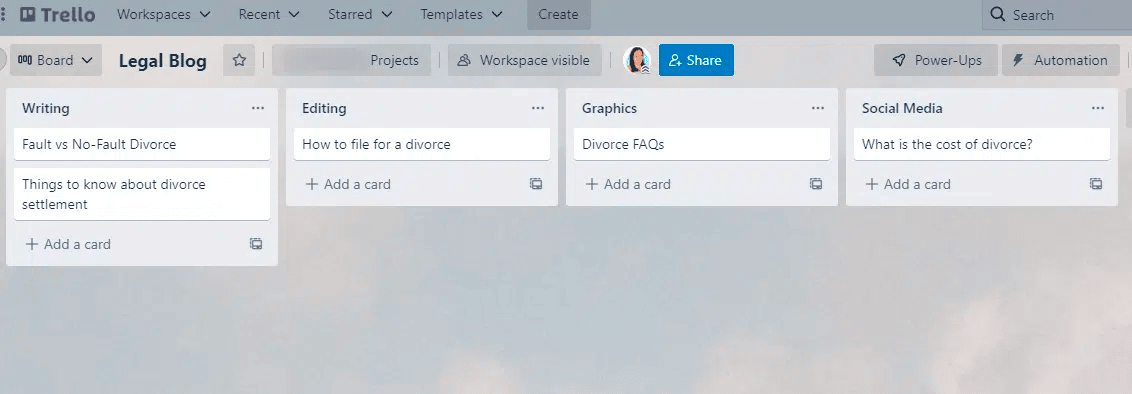
The typical stages of an article can include strategy & planning, writing, optimization, editing, adding graphics, publishing, and distribution.
Your content publishing frequency should be informed by your available resources, budget, and the competitor landscape. Generally speaking, high-quality content published regularly (say weekly) is much better than sporadic bursts.
Note: You need to ensure that you put relevant calls to action (CTAs) inside your content so that potential clients can contact you.
Create a Style Guide to Represent your Legal Brand Accurately
Before you (or your content writer) writes a single word, nail down the voice and tone for your firm’s marketing strategy.
Feel free to mention writing and language rules to keep your content on-brand. For example, Ed Hones from Hones Law Employment Lawyers PLLC ensures his firm has clear and strict internal content guidelines:

To ensure our content aligns with our branding and achieves marketing results, we maintain strict internal guidelines that reflect our mission and values. This includes using inclusive language, a consistent tone that balances empathy with professionalism, and a focus on actionable advice.

If you’re looking to work with a law firm marketing agency, this is one of the biggest reasons why you should look for a team that pays attention to your specific content needs.
At On The Map Marketing, we send a content writing questionnaire to our clients before we start. Here’s a screenshot of the same:

If you want inspiration for creating your guide, you can explore Mailchimp’s Content Style Guide:

While establishing guidelines is one thing, enforcing them is another. Be stringent when inspecting drafts prior to publishing.
For example, Mark Hirsch, co-founder of Templer & Hirsch, ensures their team goes over a strict checklist prior to publishing both in-house and outsourced content:

To guarantee that all content aligns with our brand’s visual and messaging standards and contributes to our marketing objectives, we employ a specialized in-house team that collaborates closely with external legal marketing specialists.
Furthermore, we adhere to a strict set of criteria and checklists for each piece of content before it goes live. These criteria ensure that our content is consistent in tone, accurate, and ethically presented legal advice. By incorporating these measures, we uphold a prominent brand image and secure significant marketing results, attracting clients in need of informed and reliable legal counsel.

Step 4: Create a Content Distribution Plan
With the amount of content published today, you can’t compromise on quality, but you also can’t “hope” for traffic floodgates to open on their own. You need a promotion strategy.
Typically there are three kinds of content distribution channels companies rely on: owned, paid, and earned. Here’s a nice breakdown of each by Semrush:

Law firms should aim to maximize their owned channels — especially their website, blog, and landing pages. The major distribution we rely on for our clients is building legal backlinks from external websites and internal linking across their sites. It calls for leveraging earned content distribution channels such as guest posts and brand mentions.
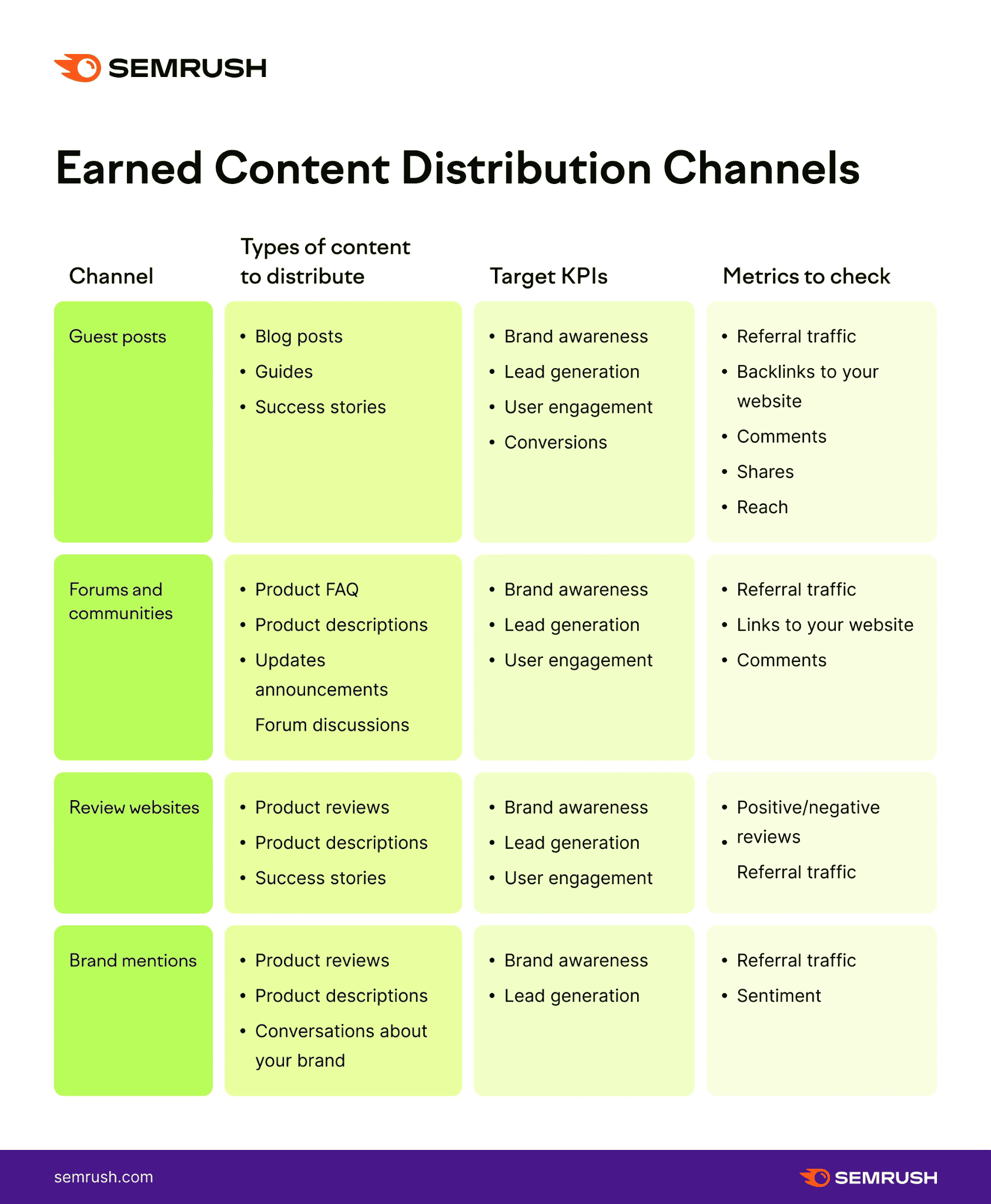
However, we do offer law firm PPC services, and if your budget allows, I reckon it’s a great strategy to bypass millions of results and get instant traction.
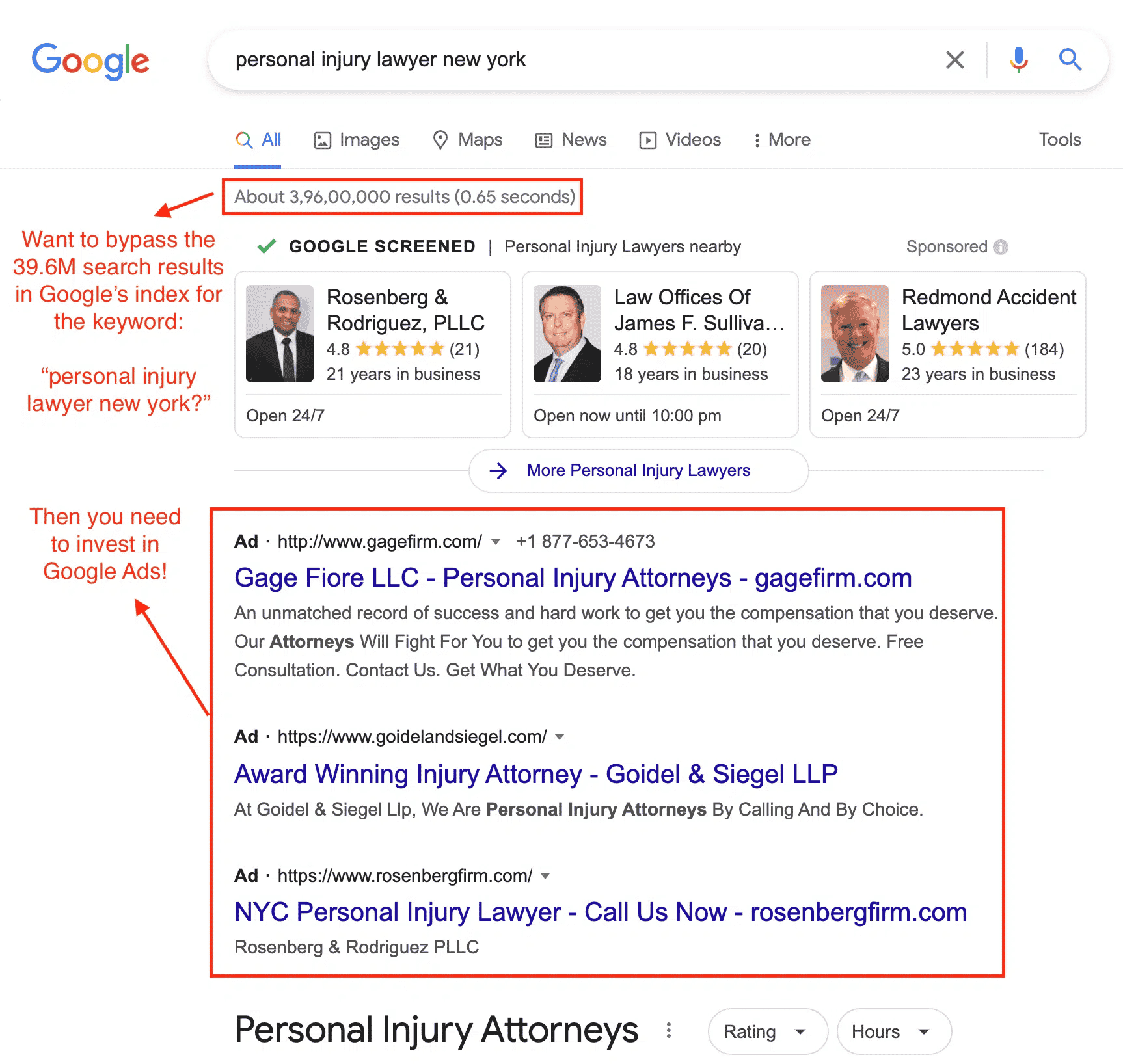
You can create a distribution plan based on how your competitors use the above marketing channels. If it sounds complicated, just begin with finding relevant websites you can write on and try to guest post on new websites twice a month.
A low hanging fruit to begin distribution is simply repurposing your top content. Got a white paper that got lots of downloads? Then, convert it into a blog post. May be conduct a webinar on the same subject.
Step 5: Measure your Content Performance after 3-6 Months
After a few months, once you have a few content pieces live on your website and distributed them — it’s time to evaluate your marketing campaign. I already shared the important metrics in the first step, but to recap the key metrics:
- Number of new cases
- Leads generated (phone calls & conversions)
- Uplift in organic rankings
- Increase in organic traffic
- Increase in referring domains (and links)
- Number of content pieces published
You can rely on third-party SEO tools like Ahrefs for tracking key metrics related to your content marketing. But it’s better to set up Google Analytics (GA) at the beginning of your content marketing efforts. Here’s a quick tutorial for the same.
At On The Map Marketing, we rely on our proprietary software, TrackRight, alongside GA for tracking our client organic rankings, traffic, phone calls & form conversions.
It can measure the overall increase in website traffic:

Track keyword rankings for all the important keywords in your location:
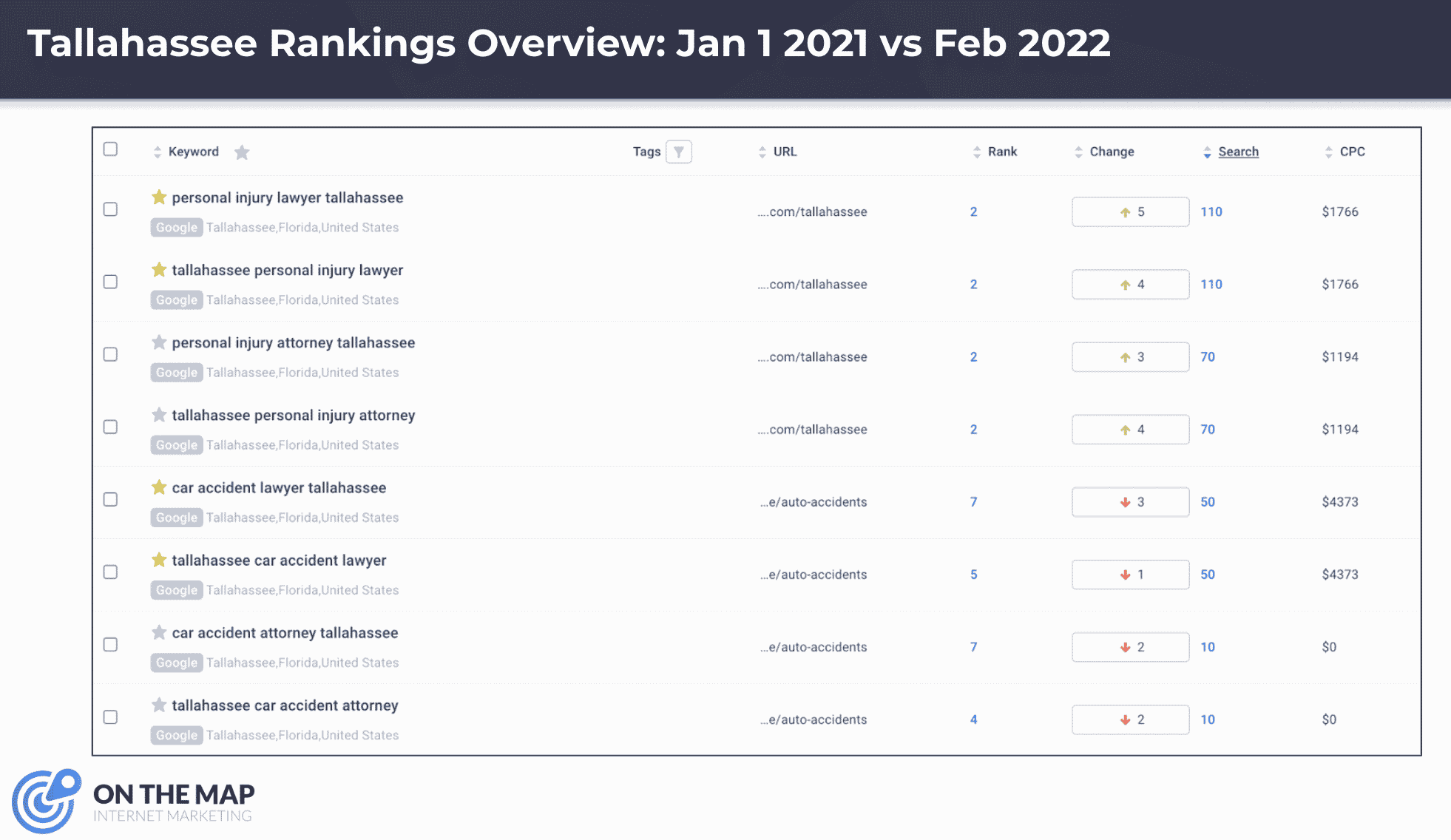
And the growth in your conversions:

Based on your performance, you can find the content and channels that work for you right now. For instance, if infographics and FAQ videos seems to drive conversions, you can do more of them.
You can also consider integrating another content type or distribution channel into the mix — if your budget and resources allow. May be integrating social media platforms can further improve your brand’s online presence.
Final Thoughts
Content marketing takes time, so most attorneys quit before it starts to show its magic. However, if you’re willing to make a long-term investment, it can become a reliable channel for high-quality legal lead generation for your firm.
I hope the steps in the article can put you on the right path to creating a sound content marketing strategy that builds trust within your community.
Table of Contents
Related Articles
Dominate Your Market with Digital Marketing Services That Deliver
Talk to a certified professional today, and we will design a strategy specific to your case.







